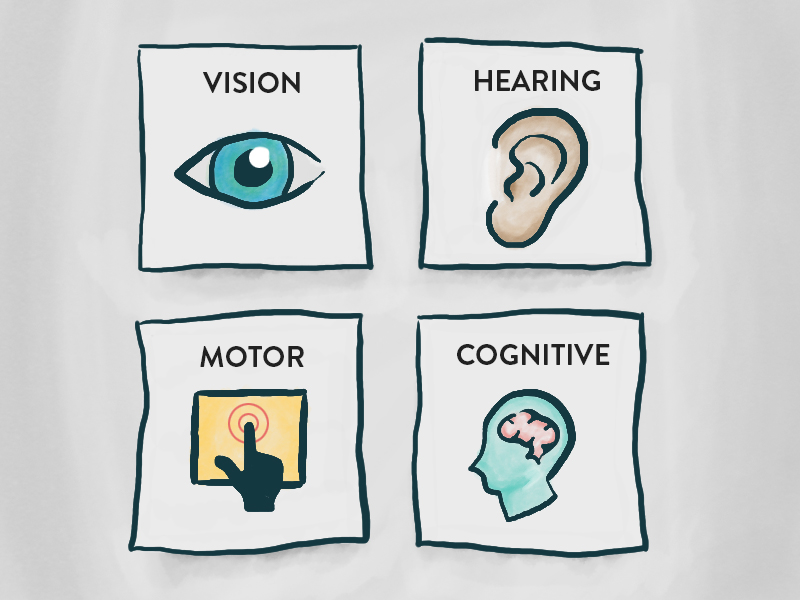Have you ever thought about how people with visual impairments navigate the world? If you’re an eye care professional, you probably have. You know the challenges people with low vision or color blindness have reading recipes or distinguishing green lights from red.But how accessible is your practice to these patients? What about your website? Even in 2017, awareness about accessibility is not as high as you’d hope. Read on to find out how to make your practice, your patient education, and your website more accessible to those with visual impairments.
No firm numbers
As eye care professionals know, almost all statistics on visual impairments and blindness are estimated because there are no generally accepted definitions for “visually impaired,” “low vision,” or “vision loss,” according to the National Federation of the Blind (NFB). The 2015 National Health Interview Survey found more than 23 million American adults age 18 and older reported experiencing vision loss.
Color blindness is less common but can also affect daily life significantly. Again, eye doctors know that the inability to perceive differences among colors can make it difficult to navigate traffic lights, read color-coded information such as bar graphs and pie charts, and even choose ripe produce at the grocery store. As many as eight percent of men and 0.5 percent of women with Northern European ancestry have the most common form of red-green color blindness, according to the National Eye Institute.
As the NFB point outs, though, specific numbers for people with low vision and color blindness don’t really matter. If a person’s sight is affected enough that they must use alternative methods to engage in any activity that someone with normal vision would do using their eyes, it’s an issue.
Key factors in accessible practice design
To make your practice as safe and accessible as possible to all patients, there are some basic factors to keep in mind. Per FamilyConnect, an online resource from the American Foundation for the Blind (AFB), the following elements are particularly important for people with visual impairments:
- Lighting, color, and contrast
- Texture and touch
- Labels and marking
- Organization and safety
Controlling lighting and glare is important. Make use of natural light if you can, and use window coverings and lamps to adjust glare. Since people with low vision may navigate spaces using a cane or “trailing,” placing their hand against the wall, keep hallways and floors clear. Tape down the edges of any rugs that may cause someone to trip, and keep doors either propped all the way open or fully closed.
Whenever possible, use more than one sense to provide information to patients. For example, think of the pedestrian intersections in many cities. There is a “detectable warning” at the bottom of the curb ramp – bumps or a change in texture that identifies the transition between the sidewalk and the street; the walk signal may include a picture of a person walking, different colors for walk and stop, and an audible tone or verbal messages.
“Redundancy and multiplicity of formats increase the likelihood that all users, including people with vision impairments” will be able to understand the information being presented and navigate the intersection safely, states the U.S. Federal Highway Administration.
Accessibility tips for videos and websites
This same advice goes for your website and any audiovisual materials you may use for patient education in your practice. Videos should include captions, or a mix of images, text, and audio, like this one:
While the NFB reports that there are few reliable current statistics on the use of computers and the Internet by blind people in the U.S., statistics do show that most people in our hyper-connected world go online, which we can assume includes those with visual impairments.
Many do so with the use of screen readers, software programs such as JAWS, ZoomText, and Window-Eyes, that read the text displayed on the computer screen with a speech synthesizer or braille display. In order to function with a screen reader, your website must meet certain accessibility criteria.
Among the key principles for accessible design is correctly using alt tags, or text alternatives to non-text content. Every image on your website needs an alt tag, which should describe the information, not the picture. For example, “picture of a patient” is not as informative as “an elderly woman undergoing intraocular lens (IOL) surgery for cataracts.”
Other tips to make websites more accessible to those with visual impairments include avoiding the use of color to convey information, and using patterns or textures on graphs or charts rather than just color. For more in-depth information and examples, see this tutorial from Envato Tuts+ on Accessibility Basics: Designing for Visual Impairment.
More than 38 percent of respondents feel that web content has become more accessible over the previous year, and 43 percent cite lack of awareness as the primary reason that many developers do not create accessible websites, according to a 2015 survey by WebAIM, a non-profit provider of comprehensive web accessibility solutions. WebAIM provides numerous resources and tools for web developers and designers looking to improve their sites’ accessibility. (See also: Do’s and Don’ts for Your Medical Practice Website)
For more ideas and tips to make your practice and patient education accessible and helpful to all your patients, get in touch with us today.

